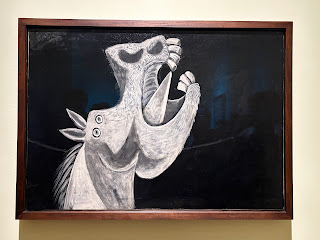 |
| Zeng Fanzhi's portrait of Picasso |
I managed to squeeze in some time this afternoon to go to M+ in West Kowloon to see the Picasso exhibit called "Picasso for Asia: A Conversation" that's on until mid-July.
 |
| Tanaami Keiichi's interpretations of Picasso's art |
More than 60 of Picasso's works were loaned from Musee national Picasso-Paris, which holds the largest and most significant collection of his art, and they are compared and contrasted with around 130 pieces of art by 30 Asian artists.
The opening painting is a portrait of Picasso by Chinese artist Zeng Fanzhi painted in 2011. It depicts Picasso as very intense with large eyes his hands muscular, and casually holding a cigarette in his right hand.
 |
| Picasso's study of a horse for Guernica |
In addition, the exhibition briefly addresses Picasso's detrimental relationships with women he considered his muses; he identified with the story of Pygmalion, a sculptor in Greek mythology who carved a statue of a woman so perfect that she came to life. He also identified with the Minotaur also in Greek mythology a character with a man's body and a bull's head, that was at times vulnerable or blind, or sexually charged and violent.
There are paintings that show his sketches for his masterpiece Guernica, and paintings of doves that soon became the global symbol of peace. The exhibition even points out that China used Picasso's paintings of doves on stamps and other propaganda.
 |
| The start of Picasso's Blue Period |
One of the rooms invites visitors to sit down and watch videos of Picasso freely painting on glass, a vase of flowers, a bull, or a dove. At one point he stops and looks at the viewer before walking away. It's fun watching him painting quickly and easily, very sure of himself and carefree.
The show also demonstrates how Picasso was greatly influenced by masters before him, and shows his interpretations of paintings by other artists, like Francisco Goya and Edouard Manet. In that way the exhibition wants to show that Picasso wasn't just considered a master, but always an apprentice wanting to learn more from others.
Meanwhile Picasso's link with Asia is tenuous -- he made one painting that was related to the Korean War called Massacre in Korea, where one can easily see how he has made direct associations to Goya's work, The Third of May1808, and Manet's paintings depicting the execution of Emperor Maximilian.
 |
| Picasso painting a vase for the viewer |
The Hong Kong Jockey Club Series: Picasso for Asia -- A Conversation
Until July 13, 2025
M+




No comments:
Post a Comment